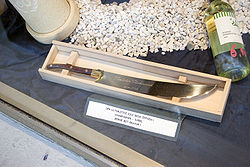
Sabrage
Encyclopedia

Sabre
The sabre or saber is a kind of backsword that usually has a curved, single-edged blade and a rather large hand guard, covering the knuckles of the hand as well as the thumb and forefinger...
, used for ceremonial occasions. The saber is slid along the body of the bottle toward the neck. The force of the blade hitting the lip breaks the glass to separate the collar from the neck of the bottle. The cork and collar remain together after separating from the neck.
History
This technique became popular in France when the army of Napoleon visited many of the aristocratic domains. It was just after the French RevolutionFrench Revolution
The French Revolution , sometimes distinguished as the 'Great French Revolution' , was a period of radical social and political upheaval in France and Europe. The absolute monarchy that had ruled France for centuries collapsed in three years...
and the saber was the weapon of choice of Napoleon's fearsome light cavalry (the Hussars). Napoleon's spectacular victories across all Europe gave them plenty of reason to celebrate. During these parties the cavalry would open the Champagne with their sabers. Napoleon, known to have said, "Champagne! In victory one deserves it; in defeat one needs it." may have encouraged this.
There are many stories about this tradition. One of the more spirited tales is that of Madame Clicquot, who had inherited her husband's small Champagne house at the age of 27. She used to entertain Napoleon's officers in her vineyard, and as they rode off in the early morning with their complimentary bottle of Champagne, they would open it with their saber to impress the rich young widow.
Champagne sword

The bottle
Bottle
A bottle is a rigid container with a neck that is narrower than the body and a "mouth". By contrast, a jar has a relatively large mouth or opening. Bottles are often made of glass, clay, plastic, aluminum or other impervious materials, and typically used to store liquids such as water, milk, soft...
neck is held at an angle of approximately 20 degrees and the sword
Sword
A sword is a bladed weapon used primarily for cutting or thrusting. The precise definition of the term varies with the historical epoch or the geographical region under consideration...
is cast down on it. The experienced sommelier
Sommelier
A sommelier , or wine steward, is a trained and knowledgeable wine professional, commonly working in fine restaurants, who specializes in all aspects of wine service as well as wine and food matching...
can open the bottle with little loss of Champagne. However, it is advised to allow a small flow in order to wash away any loose shards of glass that may be adhering to the neck. The first glass poured should also be checked for small glass shards.
Physics of sabrage
A Champagne bottle holds a considerable amount of pressure. Early bottle designs tended to explode, and the manufacturers kept making them thicker until they could contain the pressure that is caused by the release of carbon dioxide during the fermentation. The inside pressure of a typical Champagne bottle will be around 90 pound per square inches (620,528.2 Pa). The diameter of the opening is 0.7 inches (1.8 cm), so there is a force of about 35 pound-forces (155.7 N) trying to push the cork out of the bottle.At the opening of the bottle, there is a lip that creates a stress concentration
Stress concentration
A stress concentration is a location in an object where stress is concentrated. An object is strongest when force is evenly distributed over its area, so a reduction in area, e.g. caused by a crack, results in a localized increase in stress...
. On the vertical seam of the bottle the glass is not as uniform, which creates a second stress concentration. At the intersection of the seam and the lip, both stress concentrations combine and the strength of the glass is cut by more than fifty percent. The impact of the saber on this weak point creates a crack that rapidly propagates through the glass, fueled by the momentum of the saber and the pressure in the bottle. Once the crack has severed the top from the bottle, the pressure inside the bottle and the transferred momentum from the saber will send the top flying, typically for a distance of 5–10 m (16.4–32.8 ).
Competition
There is currently no world championship in Sabrage. The only way to measure skill is with a Guinness World RecordsGuinness World Records
Guinness World Records, known until 2000 as The Guinness Book of Records , is a reference book published annually, containing a collection of world records, both human achievements and the extremes of the natural world...
with the categories:
Most champagne bottles sabered in one minute - 32 and was achieved by Julio Gonzalo Chang Romero (Spain) in Marbella, Spain, on 18 April 2011
and
Most champagne bottles sabered simultaneously - Achieved by 152 participants in an event organised by International Sabrageurs Anonymous in Portarlington, Co. Laois, Ireland, on 18 July 2009
External links
- Champagne sword article on Wired NewsWired NewsWired News is an online technology news website, formerly known as HotWired, that split off from Wired magazine when the magazine was purchased by Condé Nast Publishing in the 1990s. Wired News was owned by Lycos not long after the split, until Condé Nast purchased Wired News on July 11, 2006...
- ttp://www.typicallyspanish.com/news/publish/article_30134.shtml

